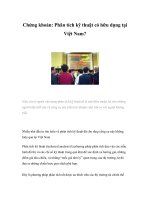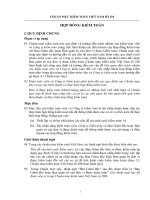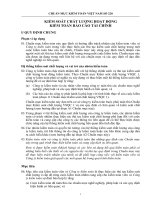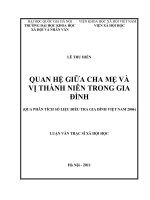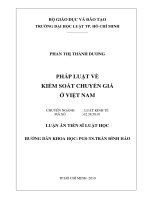Transfer price in Vietnam training Tài Liệu về chuyển giá tại Việt Nam
Bạn đang xem bản rút gọn của tài liệu. Xem và tải ngay bản đầy đủ của tài liệu tại đây (441.69 KB, 29 trang )
TRANSFER PRICE
Agenda
1.
2.
3.
4.
Scope of governing/ Application
How to test related parties
Method of determining market price
Tax administration
Legal documents
◦
Circular 66/2010/TT-BTC dated 22/04/2010 replacing Cir 117/2005/TT-BTC issued by the
Ministry of Trade
◦ Cir. 66 is effective from the 2010 tax period
◦ Applied to all transactions between related parties
SCOPE OF APPLICATION
◦ Who is subject to TP: Organizations and individuals engaged in productions and
business of goods and services, conducting all or part of business activities in VN
and having business transactions with related party shall be subject to TP disclosure
and documentation.
◦ Governing: Transactions of sales, purchase, exchange, lease, transfer or
agreements of goods or services during the course of business between related
parties.
◦ Scope of non governing: Business transactions in connection with product which
are subject to price control by the State of VN
TEST OF RELATED PARTIES
1. Control Test
2. Management Test
3. Other Test
1. CONTROL TEST
◦ By equity/ assets ownership:
oOwnership of at least of 20% shares/total assets in other companies;
oThe two companies holding common shares in another 3rd party where the common owners
hold at least 20% of shares/ total assets in the 3
rd
party;
oOwnership of at least 10% shares/ total assets by the largest shareholders in the Company
◦ By Loan relation: providing or guaranteeing loans which constitute more than 50% total of
medium & long term liabilities of another company.
2. MANAGEMENT TEST
◦ Parties are considered as related parties if:
oOne parties appoints half of executive board members of another party;
oOne parties appoints a member who decides the financial and operation affairs of another
companies;
oBoth parties have, in aggregate, more than half of the members or a single common
member on the board of directors, who decides financial or operation affairs, whereby such
members is/ are decide by the same related parties.
oThe personnel, financial or operational affairs of both parties are controlled by members of
a family (spouses, parents, children, siblings, grand parents, grand children or relatives
etc…)
3. OTHER TEST
◦ Parties have the following relation are considered as related parties:
oBetween the head office and its PE;
oBetween PEs of the same Head office
oPayment of royalty, which account for more than 50% cost of goods sold;
oSupply/ control for more than 50% of productions materials/ output
oJoint business on contractual basis.
THE NEED FOR TP REGULATIONS
◦ The information of TP regulations to regulate the transactions between related
parties which use transfer pricing as a tool for evading tax and profit
maximization
◦ “Market price” is understood as price between parties who are unrelated and on
arm length basis.
◦ To ensure that there is no transfer pricing between related parties, the company
is required to demonstrate its transaction price with related parties is similar to
“market price”.
METHOD TO DETERMINE “MARKET PRICE”
1. Comparable unrelated transaction price (So sanh gia giao dich doc
lap)
2. Resale price (Gia ban lai)
3. Cost plus profit (gia von cong lai)
4. Comparable profits (So sanh loi nhuan)
5. Profit split (Tach loi nhuan)
Priciples to determine market price:
1.
The applicable method is the one suitable to the transactional conditions and has the most
complete and reliable information/ data for comparative analysis.
2.
The Company select the most suitable price among the market range which will be used as the
basis to adjust the related transaction price. If the related party price is not less than the most
suitable value within the price range no adjustment is required.
3.
In any case there s a force majeure (e.g. disaster or fire, or regulated price by the state), the
related party is allowed to use the price in line with the practical circumstance.
Factor in determining market price
There are 4 factors:
o
Characteristics of the products (Dac tinh san pham);
o
Function of the business (Chuc nang cua co so san xuat, kinh doanh)
o
Terms and conditions of the contract (Dieu kien hop dong)
o
Economic conditions at the time of transactions (Dieu kien kinh te tai thoi diem dien ra giao dich).
1. Comparative unrelated transaction price
o
Under this method, unit price of related transaction is compared to the unit price of unrelated
transaction.
o
The primary factors (yeu to chinh) for comparison are characteristics of products and terms and
conditions of the contracts.
o
Subordinate factors (yeu to bo sung) are economic environment and functions of the business.
1. Comparative unrelated transaction price
This method is normally applied in the following cases:
o
A business establishment conducting both independent transactions and related party
transactions for the same type of product.
o
Individual transactions for each type of products circulated in the market.
o
Individual transactions for each form of services, copyright and loan agreements.
1. Comparative unrelated transaction price
Example 1:
Vespa VN is a 100% foreign invested enterprise and operates a motorbike producer and has the
following transaction in 2013:
o
Sales 1,000 LX 125 to Vespa Italy with the price of VND70 million each.
o
Sales 500 LX 125 to motor dealers with the price of VND90 million each.
The price of VND70 million is considered as not truly reflected the market price and Vespa VN is
required to impose the price of VND90 million to calculate its CIT liability.
2. Resale price
o
This method is used to determine purchase price from related parties based on adjusted resale
price to unrelated parties (i.e. less gross margin and other expense)
o
Primary factor is the function of the business.
o
Subordinate factors are economic environment, characters of the products and terms and
conditions of the contract.
2. Resale price
This method is normally applied to transactions with respect of products in the phrase of simple
services and commercial distribution which have short cycle from purchase to sales and rarely
subject to seasonal change. There are no considerable value added to the products by way of
processing, assembling, etc.
2. Resale price
NSSCV VN is a JV between NSS Corp. and NSS Thailand. The Company operates as a steel
distributor for NSS Corp. Following transaction ware noted:
o
In 2013, NSSCV received 1,000 tons steel for an amount of $55,000.
o
NSSCV sold all for an amount of $60,000
Knowing that Possco is a similar distributor and has the same operation in VND. Possco reported
gross margin in 2013 is 20%.
In this case, the cost of steel purchased from NSS Corp. shall be: $60,000 * 80%/ 120%
3. Cost Plus
This method is to determine the Sale price to related parties based on the Cost of products
(i.e.
plus margin)
This method is somehow contradictory to the resale price method.
Primary factor for considered is the functions of the business.
Subordinate
factors are economic environment, characters of the products and terms and
conditions of the contract.
3. Cost Plus
This method is normally applied in the following cases:
◦
Transaction in the phrase of production, assembly, manufacturing of products for sales to related
parties.
◦
Transaction between related parties in order to perform a joint venture contract for production,
assembly, manufacturing or processing of products or to implement agreements for supply of
inputs of productions and for off take of output products.
◦
Transactions of provisions of services to related parties.
3. Cost Plus
LV VN is a subsidiary of LV France and is responsible for processing of shoes for LV France. Its
business outcomes FY2013 are:
◦
Turnover (i.e. processing fees): VND15 billion;
◦
Cost of sales: VND13 billion;
◦
Selling and GA expense: VND1.8 billion
Knowing that Viet Tien is a similar business in textile-industry and its contract with independent
overseas vendor, the processing fees shall be determined as all cost plus 7%
In this case, LV VN’s turnover shall be:
(13 + 1.8) * 107% = VND 15,836 billion.
4. PROFIT COMPARISION
This method is to determined profit ratio of products with related transactions based on profit ratio
from unrelated transactions.
Primary factor for considered is the functions of the business.
Subordinate
factors are economic environment, characters of the products and terms and
conditions of the contract.
4. PROFIT COMPARISION
This method is considered as extension method from resale price and cost plus methods.
Therefore, this method is applied widely in the case referred in the above two method.
5. PROFIT SPLIT
This
method is to determined the profit of each related party from the total profit of a
comprehensive related party transaction based on the manner of profit split in approaches for
split:
o
Approach 1: Based on the proportion of costs and expense as incurred by each related party.
o
Approach 2: This is complicated method with two phases of profit split including the split of basic
profit (loi nhuan co ban) and split of additional profit (loi nhuan phu troi).
Factors for considerations are similar to resale price, cost plus and profit comparison method.
5. PROFIT SPLIT
This method is normally applied in the following cases:
o
The cases where related parties jointly take part in research and development of new products or
development of products being exclusive intangible assets.
o
Or transaction in the process of transitional production or business between such related parties
from raw materials to finished goods for distribution of products attached to the ownership or use
of the sole intellectual property.

